Crawler market sees improvement across North America
07 July 2022
Through the first quarter of 2022, the market for lattice boom crawler cranes showed “a little bit of growth,” according to Kobelco COO Jack Fendrick. He said the crawler market is seeing growth of 8 to 9 percent, up after a decline of some 20 percent in 2020, during the Covid pandemic.
“I have always viewed the crawler crane business as having a ‘tripod’ foundation based
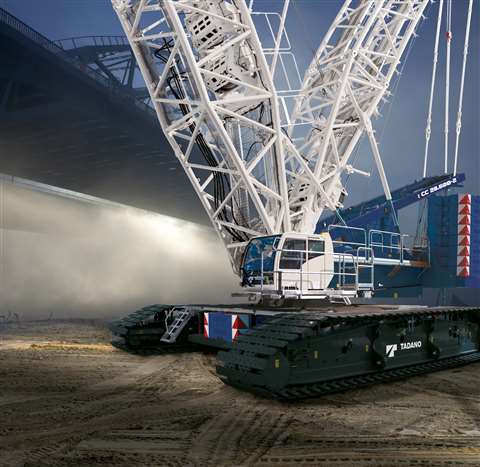 Tadano’s CC24.400-1, with a capacity of 440 tons, features a strong load capacity and the Quick Connection option for quick and easy assembly.
Tadano’s CC24.400-1, with a capacity of 440 tons, features a strong load capacity and the Quick Connection option for quick and easy assembly.
on energy, infrastructure and commercial construction,” he said. “But energy is down due to the current administration’s war on fossil fuels. We are seeing some activity, but nothing like we would traditionally, based on today’s cost of oil per barrel. In terms of infrastructure, we are seeing some activity, but again nothing like we would see after a Highway Bill is passed. Commercial is down. Covid ‘work from home’ concepts have left an abundance of empty capacity for offices.”
Fendrick said the optimistic viewpoint is that when the pendulum swings back to center, the market will see growth, perhaps even historic growth.
“The big question is when that will be,” he said. “Maybe late 2023 or early 2024.”
Link-Belt’s Kelly Fiechter, product manager for lattice and telescopic cranes, termed the crawler crane market as “busy.”
“We are busy,” he said. “Customers and dealers are busy. Everyone seems to have plenty of work. Small, medium and large businesses, everyone is busy.”
Tadano’s Allen Kadow, lattice boom crawler crane sales specialist for Tadano America, said because his company operates in the larger capacity spectrum of the crawler market, the perspective is different.
“Our crawlers start at 400 tons capacity,” he said. “The larger volume of crawler cranes sold is under 400 tons. Tadano enters the market at 400 tons so we focus on the customer base using large crawlers. Large vessel lifts and the wind industry, as an example.”
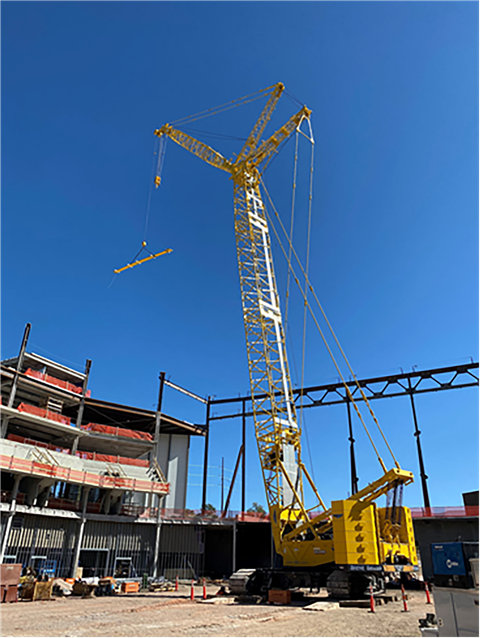
With regard to Kobelco and its North American crawler crane product line, COO Jack Fendrick said it’s been a challenging 18 months, but he is very excited about the future of Kobelco’s product range.
Engine compliance issues led the company to redesign its cranes using Isuzu engines for most of the cranes in its North American product line.
“We are seeing light at the end of the tunnel,” he said. “I am on schedule to have my full line up of cranes with new Isuzu engines available for sale in the first quarter of 2023.”
Fendrick said Kobelco has re-designed all of its crawlers and will be launching them at ConExpo in March 2023.
“85 ton, 110 ton, 120 ton, 160 ton, 200 ton, 275 ton – the brand new G-3 series will be the latest and greatest. And once again, Kobelco will be launching the entire line up at one time like we did back in 2011.”
A ‘stable’ market and the driving factors
He termed the market for the larger capacity crawlers as stable.
“The way it’s going, it looks as if this year will be about the same as last year,” he said.
Jim Jatho, product manager for lattice boom crawler and all terrain cranes for Liebherr USA, also described the crawler crane market as stable.
“For crawler cranes up to 300 metric tons, we did notice a lower demand in 2020, but an increase in demand in 2021 and 2022,” Jatho said. “At this time, we see the large crawler crane market on the verge of a turnaround from the currently slower market environment. Many customers and contractors predicted the revival of the onshore wind market beginning in Q3 of this year.”
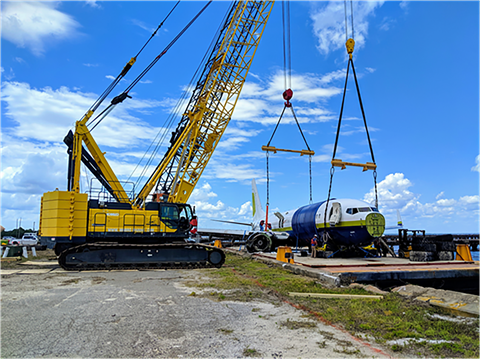 Mobro Marine used its Kobelco CK1600G-2 to lift a damaged Boeing 737 from the water and onto a barge.
Mobro Marine used its Kobelco CK1600G-2 to lift a damaged Boeing 737 from the water and onto a barge.
Overall, the large crawler crane customer inquiries as well as orders for new large crawler cranes for the next year(s) point to a strong market, Jatho said.
Several different factors drive crawler crane demand, according to Brennan Seeliger, product manager for crawler cranes at Manitowoc.
“One of the most notable is the wind energy market,” Seeliger said. “The configurations used in these applications are rather unique and do not necessarily cross over to other markets. Another is the industrial sector – refinery, chemical, petrochemical and other large processing operations. They are big drivers for larger crawler cranes.”
For smaller crawlers, general construction, such as apartment buildings, parking garages and low-rise commercial buildings, are projects that create demand, Seeliger said.
“Roads, bridges and infrastructure, such as rail and port projects, are important segments for crawlers of various sizes,” he said. “Recently we’ve seen quite a few customers procuring Manitowoc cranes for bridge work.”
Link-Belt’s Fiechter said that traditionally, longer term projects, such as plant work, industrial work and large projects, have been the drivers of crawler crane work.
“Today, I don’t how much of that is going on,” said Fiechter. “Foundation and bridge work, pre-cast structures and some institutional work is what we are seeing. We are not seeing the industrial work or a lot of oil and gas work so far. The market is a little different than it has been.”
He concurred with Seeliger about bridge jobs.
“Bridges are being replaced in packages, several bridges at a time,” Fiechter said. “We may be seeing new ways of jobs being let that we haven’t seen in the past. Instead of work on one large bridge, it’s an eight or 10 bridge package.”
The good news is that there are ample projects to keep crawler cranes busy and customers adding these cranes to their fleets, he said.
Job pipeline full
“When the pandemic hit and the brakes were slammed on this market, there were a lot of jobs in the pipeline,” Fiechter said. “I think things are busy and the market is steady, but what we are seeing today is the work that was in the pipeline.”
For Link-Belt, which offers crawlers from 80 to 300 tons capacity, the feature that customers want most is transportability.
“We lead the pack in terms of transporting our crawler cranes,” Fiechter said. “Our crawlers are designed to self-assemble and they are easy to operate. All our cranes operate the same way, which is an advantage.”
Link-Belt is aggressive about product development, and Fiechter said they want to produce what customers need.
“Right now, we like the product mix we have,” he said. “I don’t see anything going away.”
In terms of getting product out the door, Fiechter said Link-Belt has experienced the same challenges as other crawler OEMs.
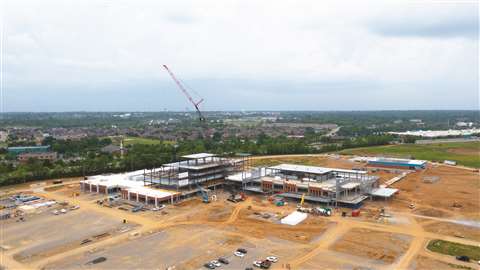 A 300-ton Link-Belt 348 Series 2 erects steel at a hospital project in Lexington, KY.
A 300-ton Link-Belt 348 Series 2 erects steel at a hospital project in Lexington, KY.
“All the steel for our crawler crane attachments is sourced in America,” he said. “The booms and fixed jibs are all manufactured in the U.S. so we are not having to wait on any ships for boom. Thus far we haven’t seen huge delays for our cranes arriving at port.”
Since the beginning of the pandemic, Liebherr also has been experiencing an unstable supply chain.
“Covid-related lockdowns and the war in Ukraine have also made this situation worse globally,” said Jatho. “We have been able to keep up the production of our mobile and crawler cranes almost completely, and despite these difficulties, we have even been able to increase the quantities.”
In general, the supply chain situation and inflation are leading to rising prices on the procurement markets, according to Jatho.
Tadano’s Kadow said that wind energy work has been a big driver over the past couple of years. He anticipates that offshore wind work will also stimulate sales as large capacity crawlers are needed to lift components from shore to ships.
As far as capacities, he said there are three tiers – 400 to 499 tons, 500 to 699 tons and then 700 tons and up.
“Most of the demand for cranes over 400 tons is in the 500 to 699 class,” Kadow said. “In these classes, the 1,000 to 1,200 tons to 1,600 tons and up, are really designed for the big work in petrochemical plants. There is only so much work for these capacities.”
Tadano’s biggest seller is the CC 38.650-1 (formerly known as the CC-3800), The crane has a capacity of 650 metric tons.
“This crane is excellent performing wind work, and we offer applications like the Boom Booster in response to the increasing heights of wind turbines,” Kadow said. “When we got in the wind business, wind tower heights were 55 to 60 meters and now they are upwards of 100 meters and getting taller and heavier with the newer 4 MW cells.”
While Kadow was mum about product development, he said Tadano is always assessing new products launches. As for future demand for larger capacity crawlers, Kadow is cautiously optimistic.
“We expect demand in 2023 for large crawler cranes over 400 tons to remain stable,” he said. “In the past, when oil barrel prices reached $80, demand for crawlers shot up. It’s seeming like we are seeing a paradigm shift this time around as more and more countries turn towards green energy,” Kadow said.
Manitowoc’s Seeliger said the demand for cranes working in the wind sector has meant changes for machines that are operating in those environments.
“The growth in that market has driven the need for larger machines, such as our MLC650,” he said. “Just 10 years ago, a 400-ton crane would be enough for most wind work, and now we’re looking at doing that same work with the MLC650 (with a 650 metric ton capacity.”
Manitowoc’s main wind sector crawlers are the Manitowoc MLC300 and MLC650, both of which have Manitowoc’s patented Variable Position Counterweight (VPC) technology feature.
“VPC enables us to complete the same work but with a smaller crane than our competition,” Seeliger said. “Being able to utilize a smaller crane to complete the same work benefits everybody up and down the line.”
But Manitowoc has also seen an increase in demand for its smaller machines.
“Smaller road and bridge contractors are gearing up for work that they’re seeing coming down the pipe,” he said. “That trend falls in line with our latest product launches, the MLC100-1 and MLC150-1. They’ve been well received and fit into the market well with the uptick in road and bridge work.”
Manitowoc’s product development efforts are robust, Seeliger said.
Further innovations in crawler technology
“An example that is quite evident is our new Wide Boom Plus inserts kit for the MLC300 that we just are launching after identifying a need in the market,” he said.
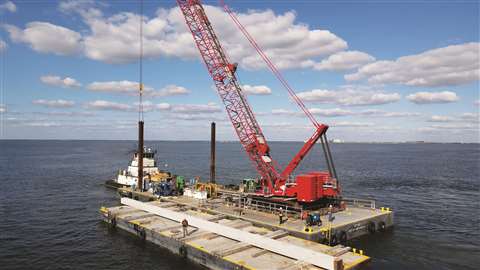 Manitowoc has expanded its boom insert offering with the new Wide Boom Plus kit for its MLC300 lattice-boom crawler crane. The new inserts will give crane operators extra reach by lengthening their booms up to 429.8 feet. They will be particularly useful for assembling wind turbines.
Manitowoc has expanded its boom insert offering with the new Wide Boom Plus kit for its MLC300 lattice-boom crawler crane. The new inserts will give crane operators extra reach by lengthening their booms up to 429.8 feet. They will be particularly useful for assembling wind turbines.
According to Liebherr, traditional drivers of the crawler market include large infrastructure projects and bridges, high-rise non-residential and residential buildings and U.S. infrastructure. Oil and gas and wind projects also stimulated the large crawler crane market. In recent years, the main driver for large crawler cranes has been the onshore wind market, according to Liebherr’s Florian Ritzler, sales manager for crawler cranes, Liebherr-Werk Ehingen.
“Large capital projects such as sports stadiums have slowed down during Covid,” said Ritzler. “The newest, and potentially biggest driver will likely be the offshore wind industry and the surrounding environment. The offshore wind industry will see a demand for a broader range of crawler cranes rather than the traditional base/mid and main erection cranes seen in onshore markets. Liebherr’s range of crawler crane size classes are ideally suited for this emerging market with a focus on supporting the renewable energy sector.”
Over the past few years, demand for the bigger size classes has progressively grown, Ritzler said. Demand is strong for the LR 11000 in the onshore wind market, he said.
“Interest has picked up in our 500 metric ton and 700 metric ton class crawlers as the LR 1500 excels in maintenance and repower work, and the LR 1700-1.0 will become the crane of choice once turbine hub heights rise beyond 120 meters.”
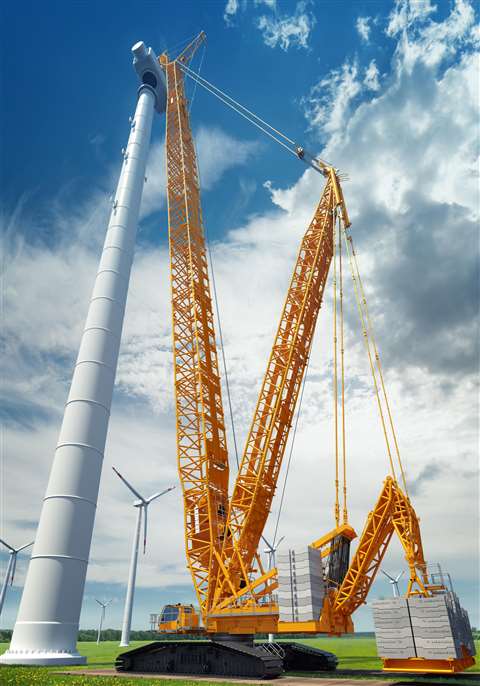 In recent years, the main driver for large capacity crawler cranes has been the onshore wind market. Pictured is a Liebherr LR 1700-1.0 placing a hub. Crawler OEMs anticipate that offshore wind work will be a big market as well.
In recent years, the main driver for large capacity crawler cranes has been the onshore wind market. Pictured is a Liebherr LR 1700-1.0 placing a hub. Crawler OEMs anticipate that offshore wind work will be a big market as well.
Besides transportability, consistency in design across the Liebherr fleet is seen as an advantage for rental crane companies, according to Wolfgang Pfister, head of strategic marketing and communications, Liebherr-Werk Nenzing.
“The basic concepts do not change drastically, so moving from one size class to another is a smooth process,” he said.
Ritzler said Liebherr has begun using some of the same components across different size classes, such as the M-wagon, which can be utilized across the LR 1700-1.0, LR 1800-1.0 and LR 11000 platforms.
Liebherr also is offering new safety features for crawler cranes up to 400 metric tons, including its ground pressure reduction system and gradient travel aid.
Also aggressive in product development, Liebherr added the LR 1700-1.0 to replace the LR 1600/2.
“We are also focusing on new markets and applications by adding the LR 12500-1.0 to fill the niche between LR 11350 and LR 13000,” said Ritzler. “Our existing crawlers received improvements to ensure the latest technology, like adding a V-frame on the LR 11000 and increasing the counterweight on the LR 1500 to improve the capacity for S, SL6 and SW operations without derrick.”
Liebherr recently launched the world’s first battery powered crawler, the LR 1250.1 unplugged. The unplugged series includes the LR 1200.1 unplugged and the LR 1160.1 unplugged. Liebherr will show showcase several crawler cranes at Bauma in October in Germany, including the new LR 1400 SX and the new LR 1100.1.
STAY CONNECTED


Receive the information you need when you need it through our world-leading magazines, newsletters and daily briefings.




